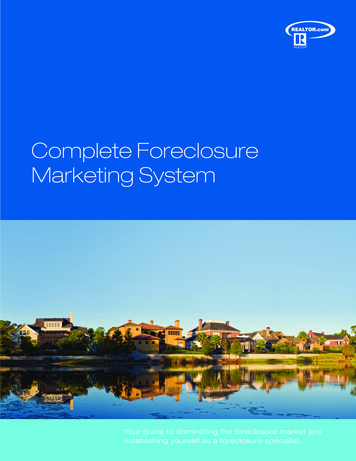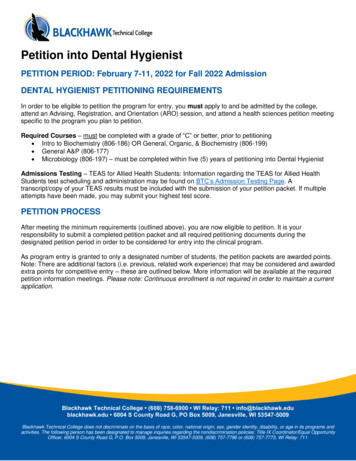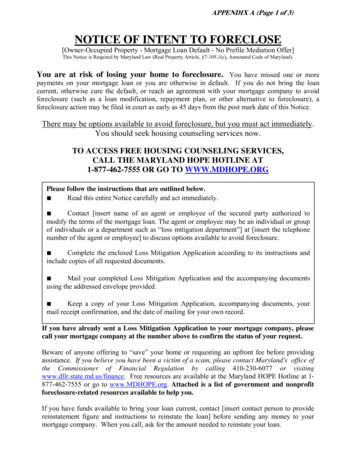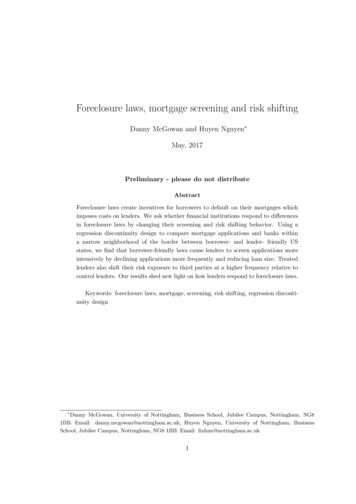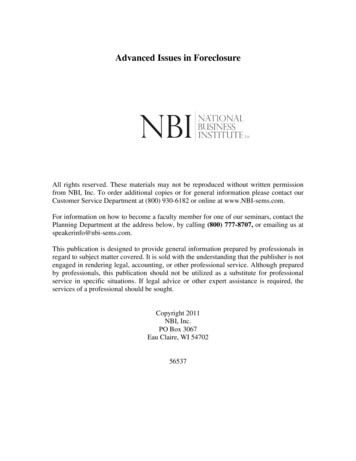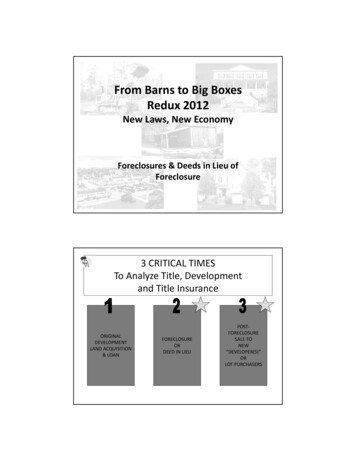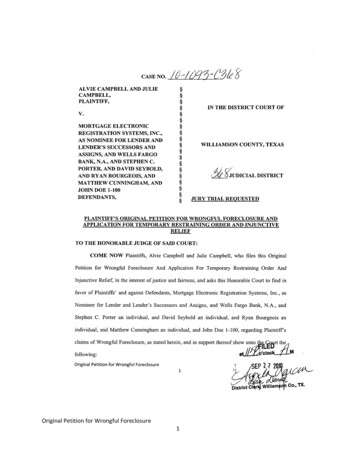
Transcription
Original Petition for Wrongful Foreclosure1
CASE NO.ALVIE CAMPBELL AND JULIECAMPBELL,PLAINTIFF,V.MORTGAGE ELECTRONICREGISTRATION SYSTEMS, INC.,AS NOMINEE FOR LENDER ANDLENDER’S SUCCESSORS ANDASSIGNS, AND WELLS FARGOBANK, N.A., AND STEPHEN C.PORTER, AND DAVID SEYBOLD,AND RYAN BOURGEOIS, ANDMATTHEW CUNNINGHAM, ANDJOHN DOE §§IN THE DISTRICT COURT OFWILLIAMSON COUNTY, TEXASJUDICIAL DISTRICTJURY TRIAL REQUESTEDPLAINTIFF’S ORIGINAL PETITION FOR WRONGFUL FORECLOSURE ANDAPPLICATION FOR TEMPORARY RESTRAINING ORDER AND INJUNCTIVERELIEFTO THE HONORABLE JUDGE OF SAID COURT:COME NOW Plaintiffs, Alvie Campbell and Julie Campbell, who files this OriginalPetition for Wrongful Foreclosure And Application For Temporary Restraining Order AndInjunctive Relief, in the interest of justice and fairness, and asks this Honorable Court to find infavor of Plaintiffs’ and against Defendants, Mortgage Electronic Registration Systems, Inc., asNominee for Lender and Lender’s Successors and Assigns, and Wells Fargo Bank, N.A., andStephen C. Porter an individual, and David Seybold an individual, and Ryan Bourgeois anindividual, and Matthew Cunningham an individual, and John Doe 1-100, regarding Plaintiff’sclaims of Wrongful Foreclosure, as stated herein, and in support thereof show unto the Court thefollowing:Original Petition for Wrongful Foreclosure2
DISCOVERY CONTROL PLAN LEVEL1. Pursuant to Rule 190.1 of the Texas Rules of Civil Procedure, Plaintiffs’ intends to conductdiscovery in this case under Level 3.PARTIES AND SERVICE2. Plaintiffs’ Alvie Campbell and Julie Campbell are individuals whose mailing address is 250Private Road 947, Taylor, Texas, 76574. The last three digits of Alvie Campbell’s driver'slicense number are 578, and the last three digits of his social security number are 180. Thelast three digits of Julie Campbell’s driver's license number are 933, and the last three digitsof her social security number are 938.3. Defendant Mortgage Electronic Registration Systems, Inc., as Nominee for Lender andLender’s Successors and Assigns is a Foreign For-Profit Corporation and may be served at3300 S.W. 34th Avenue, Suite #101, Ocala Florida, 34474-7448. Service on this defendantmay be effected by personal service or Certified Mail Return Receipt Requested.4. Defendant Wells Fargo Bank, N.A., is a National Banking company who may be served byand through its registered agent, CT Corporation System, at 211 E. 7th St. Suite 620, Austin,Texas 78701 USA. Service on this defendant may be effected by personal service orCertified Mail Return Receipt Requested.5. Defendant Stephen C. Porter, is an individual who may be served at 15000 Surveyor Blvd,Suite 100, Addison, Texas 75001. Service on this defendant may be effected by personalservice or Certified Mail Return Receipt Requested.6. Defendant David Seybold, is an individual who may be served at 15000 Surveyor Blvd, Suite100, Addison, Texas 75001. Service on this defendant may be effected by personal service orCertified Mail Return Receipt Requested.Original Petition for Wrongful Foreclosure3
7. Defendant Ryan Bourgeois, is an individual who may be served at 15000 Surveyor Blvd,Suite 100, Addison, Texas 75001. Service on this defendant may be effected by personalservice or Certified Mail Return Receipt Requested.8. Defendant Matthew Cunningham, is an individual who may be served at 15000 SurveyorBlvd, Suite 100, Addison, Texas 75001. Service on this defendant may be effected bypersonal service or Certified Mail Return Receipt Requested.JURISDICTION AND VENUE9. The subject matter in controversy is within the jurisdictional limits of this Court.10. This Court has personal jurisdiction because the property which is the subject of thislitigation is located in Texas and Defendants are doing business within this state.11. Venue in this cause is proper in Williamson County, Texas pursuant to Section 17.56 of theTexas Business and Commerce Code and under Section 15.001 of the Texas Civil Practiceand Remedies Code because this action involves real property, and the property is located inWilliamson County, Texas.FACTS12. Plaintiffs’ were the record owner of the property is located at 250 Private Road 947, Taylor,Texas, 76574, more specifically described as LOT 3, DOVE MEADOW NORTHACCORDING TO THE MAP OR PLAT THEREOF RECORDED IN CABINET X, SLIDE293 OF THE PLAT RECORDS OF WILLIAMSON COUNTY, TEXAS.13. Plaintiffs’ allegedly signed a Promissory Note in order to purchase the property located at250 Private Road 947. Taylor, Texas, 76574 on October 29, 2004 with American MortgageNetwork, Inc. “AMNET” with loan number # 204-796205. Attached as Exhibit “A”Original Petition for Wrongful Foreclosure4
14. Plaintiffs’ allegedly signed a Deed of Trust as security for the note on October 29, 2004, withAmerican Mortgage Network, Inc. “AMNET”, which was allegedly recorded in the office ofthe County Clerk of the Deed of Trust Records of Williamson County, Texas. Attached asExhibit “B”15. In December, 2004, “Wells Fargo Home Mortgage” provided the “borrowers” with a newloan number, that being 708-0195808399 and said “borrowers” were to now pay them. WellsFargo Home Mortgage said they were the new mortgage servicer. Wells Fargo HomeMortgage was not an “original party” to the “original negotiable instrument” which“borrowers” negotiated. Wells Fargo was a 3rd party debt collector, pretending to be theLender. Wells Fargo failed to adhere to the Fair Debt Collection Practice Act, as all 3rd partydebt collectors are required to do.16. Barrett, Daffin, Frappier, Turner & Engel, LLP, (“BDTFE”)agents for Defendants, whoseaddress is 15000 Surveyor Blvd, Suite 100, Addison, Texas, 75001, sent Plaintiff a Notice ofSubstitute Trustee’s Sale (the “Notice”) dated July 9, 2010, attached as Exhibit “C” heretoand incorporated as if stated fully herein, stating that a foreclosure sale was scheduled forSeptember 7, 2010 in Williamson County, Texas. That sale occurred as scheduled, by JohnLatham, whose address is 15000 Surveyor Blvd, Suite 100, Addison, Texas, 75001, andwhereupon Wells Fargo Bank, N.A. (“WFBNA”) purchased the subject property at saidSubstitute Trustee’s Non-Judicial Sale.17. On July 26, 2010 Plaintiff’s sent via Certified mail requesting, in writing, that the Defendantsproduce lawful documents showing a valid perfected security instrument existed. There neverwas such a production and per public records no such document could have been produced.The fact is, no such lawful document (valid perfected security instrument) in this instanceOriginal Petition for Wrongful Foreclosure5
could have been offered up to prove rights of enforcement by a foreclosure action by theDefendants. Attached as Exhibit “D”18. On July 30, 2010, Defendants agents, Ryan Bourgeois of Barrett Daffin Frappier Turner &Engel, LLP, responded to Plaintiffs request for validation with a package consisting ofscanned copies of an assignment of deed of trust, a note, deed of trust, appointment ofsubstitute trustee, and a letter to Mr. Grisham. Ryan Bourgeois then stated in the response“Our dispute is now over and we will proceed with the scheduled September 7, 2010foreclosure sale”. Attached as Exhibit “E”VALIDITY OF FRAUDULENTLY CREATED DOCUMENTS19. As noted in the transcript of the Meeting of the Task Force on Judicial Foreclosure RulesNovember 7, 2007, (note pages 27, 28 and 33), as found on the Supreme Court of Texaswebsite 10707transcript.pdf), makes issuewith, addresses and discloses the same fraudulent practices, Defendants produced as suchfraudulent documents to accomplish their actions to wrongfully foreclose on Plaintiffs’property . This was an unlawful foreclosure. Attached as Exhibit “F”20. On page 27, lines 6-22, Mr. Mike Barrett of Barrett Daffin Frappier Turner & Engel stated;“There really isn't such a document” during the discussion about verification of applicationdocuments.21. On page 27, Lines 10-20, Mr. Barrett continued to state; “because the servicer usuallyacquired their position in the file through the purchase of MSRs. There is an organizedmarket in MSRs that really makes up maybe as much as 40 to 50 percent of any mortgagecompany's assets, and they acquired this -- their status of being a servicer through thepurchase of an MSR most of the time, or they did it themselves, they created their own loan.Original Petition for Wrongful Foreclosure6
So finding a document that says, "I am the owner and holder, and I hereby grant to theservicer the right to foreclose in my name" is an impossibility in 90 percent of the cases.”22. On Page 28, lines 8-20, Honorable Judge Bruce Priddy stated: “And what the -- happens isthey just execute a document like Mr. Barrett say doesn't exist. They just create one for themost part sometimes, and the servicer signs it themselves saying that it's been transferred towhatever entity they name as applicant”.23. On pages Page 25, lines 16-25, page 26, lines 1-15, Mr. Tommy Bastian of Barrett DaffinFarppier Turner & Engle, LLP, explained MERS; “MERS is going to be the mortgagee ofrecord. In about 60 percent of all loans MERS is going to be the mortgagee of record, but allMERS is is a registration system. That's all it is. It really is a piggyback on what happened inthe securities market back in the early Seventies when Wall Street was exploding, and back inthose days whenever you bought and sold stocks or bonds you had to have a papercertificate. Well, the back rooms couldn't keep up with it, and Wall Street almost cratered,and they came up with a book entry system that everybody is familiar with today where loansare bought and sold, and that's basically what MERS is. It's just a listing of who has all thebeneficial ownership interest in a mortgage, and that's going to be the investor, it's going tobe the mortgage servicer, it's going to be the subservicers. It gives you four or five, six piecesof corroborating information about the borrower and that particular loan. I mean, it has thedetail on their status sheet that says, "This is when the loan was made, here is the borrower,and here's the amount of the loan." I mean, all that information is right there so that if theloan is registered on MERS it's real easy to determine all the different parties in thetransaction, and that's the way the world's going, so maybe that's kind of the place we needto be going.”24. Plaintiffs have therefore been required to expend time and effort to defend an action that hadno legal basis, in regards to the original lenders unsecured Debt.25. A Broken Chain of Assignments, rendered the “Deed of Trust” void and unenforceable,under UCC 3-201, 3-204 & 3-302, therefore no activation of the “Power of Sale” clause inthe “Deed of Trust” was allowed or was lawful according to Texas laws.Original Petition for Wrongful Foreclosure7
BIFURCATION OF ORIGINAL LENDERS SECURED DEBT - LOSS OFPERFECTION OF THE SECURITY INSTRUMENT26. Plaintiff’s as grantors originally recorded alleged Deed of Trust as Instrument # 2004086763in Williamson County public records to the grantee, American Mortgage Network, Inc.(“AMNET”) per the Texas Local Government Code, chapter 192, section 001, which states;Sec. 192.001. GENERAL ITEMS. The county clerk shall record each deed, mortgage, orother instrument that is required or permitted by law to be recorded. Attached as Exhibit “B”27. Defendants attempted to gain control of the security instrument without the propernegotiation of the note to the Defendants and their claim of ownership of the securityinstrument is without merit. The true fact is that at the time MERS claimed ownership to thesecurity instrument, perfection of the lien had been lost due to bifurcation.28. Defendants attempt of an assignment of the mortgage that was already bifurcated by theoriginal lender back to the note was not in compliance with lien perfection according hichstates:Sec. 192.007. RECORDS OF RELEASES AND OTHER ACTIONS. (a) To release, transfer,assign, or take another action relating to an instrument that is filed, registered, or recordedin the office of the county clerk, a person must file, register, or record another instrumentrelating to the action in the same manner as the original instrument was required to be filed,registered, or recorded. The fact is, there has been no legal filing transferring lien rights.29. Defendants Vice President of Loan Documentation, Stephen C. Porter, who is also counselfor Barrett Daffin Frappier Turner & Engel, LLP, signed the Appointment of SubstituteTrustee to John Latham c/o Barrettt Daffin Frappier Turner & Engel, LLP on September 08,2008 and recorded as Instrument # 2008071378 on September 16, 2008 in WilliamsonOriginal Petition for Wrongful Foreclosure8
County public records but lacked legal authority to execute such action as AmericanMortgage Network, Inc. per public records would still be the correct party to the recordedinstrument. Attached as Exhibit “G”30. Defendants Assistant Secretary, David Seybold, who is also counsel for Barrett DaffinFrappier Turner & Engel, LLP, recorded Instrument # 2008085222, “Assignment of Noteand Deed of Trust” from MERS to Wells Fargo Bank, N.A on September 30, 2009, with an“effective date of assignment” in August 22, 2008 without legal authority to do so. Attachedas Exhibit “H”31. Through the actions of David Seybold, Assistant Secretary of MERS, the assignment ofmortgage recorded as Instrument # 2008085222 in Williamson County public records, is theproof needed to show separation of the security instrument from the negotiable instrumenthad occurred, therefore the original lenders secured debt was rendered unsecured, thesecurity instrument being a nullity and is out of reach of the negotiable instrument.32. The bifurcation of the note and security instrument resulted in the original lenders securityinstrument being unenforceable and the power of sale clause contained within the nullifiedsecurity instrument unenforceable. Therefore, the trustee sale of the Plaintiff’s property wasnot lawful.33. The assignment of mortgage executed by MERS from MERS to Wells Fargo was not properto the chain of title. MERS could not acknowledge an assignment of the mortgage.American Mortgage Network, Inc.(“AMNET”) as the holder of the note was the only properparty with authority to assign the note and if a valid perfected lien had existed suchassignment of mortgage and upon filing in public records such assignment of mortgageOriginal Petition for Wrongful Foreclosure9
would have been perfected in a subsequent parties name at which the security instrumentthen would have followed the note.34. Although American Mortgage Network, Inc. may claim recordation of the “assignment of themortgage” which reflects the negotiation of the negotiable instrument, are not a requiredaction in regards to the Texas Business and Commerce Code and the Texas Property Code,American Mortgage Network, Inc., MERS and Wells Fargo have failed to review the“security instrument”(Deed of Trust), Section 14. (Governing Laws; Severability),”ThisSecurity Instrument shall be governed by Federal law and the law of the jurisdiction in whichthe property is located”. MERS and/or Wells Fargo claims that compliance is not required isalso misplaced.35. According to Texas Local Government Code 192.007, American Mortgage Network, Inc. didhave a duty to record an assignment of the mortgage in public records. If such assignmenthad occurred then MERS and Wells Fargo would have had a duty to record any subsequentassignment of the mortgage.36. MERS, nor Wells Fargo Bank, N.A. had any legal authority to foreclose on “Borrower’s”real property due to the separation or bifurcation of the negotiable instrument and the securityinstrument.37. The assignment of the mortgage by MERS was an unlawful attempt to assign the mortgage toan indebtedness in an attempt to unlawfully obtain real property. This action was an illegalaction to try to reconnect the security instrument to the note to give appearance of a securedindebtedness, but in reality the indebtedness is unsecured.38. Defendants’ have yet to produce such documents that show a valid security instrument existsmuch less the right to enforce their alleged indebtedness. It is Plaintiffs’ belief that theOriginal Petition for Wrongful Foreclosure10
Defendants did not have the authority to foreclose on the property and are in fact not theactual holders of the original note or a properly perfected security instrument, and thereforeDefendants are not entitled to collect on a debt. Only the original creditor could achieve this.39. On information and belief, Plaintiffs’ alleges that Defendants were never the actual Holder ofthe Original Note or the owner of a valid perfected security instrument; have never providedany proof they were the duly appointed representative(s) for the actual Holder of the OriginalNote; were not the actual Holder of the Original Note between the time the Notice was issuedand the time that the Substitute Trustee’s Sale occurred; and were not the duly appointedrepresentative(s) for the actual Holder of the Original Note between the time the Notice wasissued and the time that the Substitute Trustee’s Sale occurred. In fact, American MortgageNetwork, Inc. (“AMNET”) has been the actual Holder of the Note since at least October 29,2004, as indicated by Exhibit “A” attached hereto and incorporated as if stated fully herein.There is nothing in Defendants’ documentation or in the public record indicating thatDefendants are, or have been, acting with the authorization of American Mortgage Network,Inc. (“AMNET”) in this matter. Accordingly, Defendants did not have authority to forecloseon the property and were not entitled to collect on the alleged debt.COUNT I: WRONGFUL FORECLOSURE40. Plaintiffs’ re-alleges and incorporates by reference the foregoing allegations.41. The Defendants foreclosure action was wrongful. The Deed of Trust is not enforceable due tothat lack of ownership in the note by the Defendants and if such lawful owner of theindebtedness was to prove up a proper Note, bifurcation of the note and the securityinstrument has been proved by an assignment of the mortgage by an intrusive non-party thatwas not "Holder in Due Course".Original Petition for Wrongful Foreclosure11
42. A foreclosure action is merely a collection action on a negotiable instrument, namely theOriginal Promissory Note. A Deed of Trust acts as a security instrument for the OriginalPromissory Note. A foreclosure action is a collection on the Original Promissory Note, noton the Deed of Trust. The Texas Business and Commerce Code states that only a “Holder” ofa negotiable instrument is entitled to enforce the negotiable instrument. But if such securityinstrument is invalid then the "holder" can only pursue the indebtedness of the "note".43. All the documents relating to the foreclosure sale, which occurred on September 7, 2010,refer to the “Holder” of the Note, but Defendants have not shown themselves to be saidHolder and/or the duly authorized representatives of the Holder, and even less so have notproved that there was a lawful right to enforce terms within the security instrument.44. The Notice was defective and invalid because it describes the original mortgagee as MERSand the current mortgagee as “Wells Fargo Bank, N.A.”On information and belief,American Mortgage Network, Inc. “(AMNET”) as lender should have been the beneficiaryand mortgagee within the security instrument and filed of record which then such securityinstrument would have been properly perfected in public records. Therefore any notice,acceleration, default or any other notice by defendants is without merit and ineffective.45. Despite Defendants’ knowledge of the dispute regarding Defendants’ right to foreclose,Defendants pursued the foreclosure sale of the subject property under the use of a nullifiedDeed of Trust.46. To date, Defendants have failed to demonstrate, and cannot demonstrate, the proper allonges,transfers, and assignments affixed to the Note permanently and irremovably, as required bythe Texas Business and Commerce Code, that are required to show a proper chainindorsements on the face of the Note which should be supported by the chain of title filedOriginal Petition for Wrongful Foreclosure12
with public records. In fact, the alleged assignment of the mortgage filed in the WilliamsonCounty, Texas property records and dated “effective August 22,, 2008” attach as Exhibit“G”, purports to assign the Deed of Trust from the assignor, Mortgage ElectronicRegistration Systems, Inc. as Nominee for Lender and Lenders Successors and Assigns, tothe assignee, Wells Fargo Bank, N.A. On information and belief, American MortgageNetwork, Inc. (”AMNET) held the Note at that time, making it impossible for saidassignment to represent the actual state of ownership and impossible for said assignment torepresent a true and correct filing in the public records.47. Defendants have not demonstrated, and cannot demonstrate, either their status as the true andlegal “Holder” of the Original Note, or their authority to conduct the foreclosure. Defendantsnever had a secured debt where terms within the security instrument was enforceable, as theinvalid Deed of Trust they used was not enforceable.48. All Defendants have purposefully, intentionally, and wrongfully instructed and carried out acollection action by way of the foreclosure and Substitute Trustee’s Non-Judicial ForeclosureSale in violation of the Texas Finance Code sections 392.301(8) and 392.304 and othervarious State laws.49. Upon review of Instrument # 2010062035, Substitute Trustee’s Deed, recorded inWilliamson County Public Records on September 16, 2010, the affidavit contained withinsaid Trustee’s Deed is written by Matthew Cunningham of National Default Exchange,whose address is 15000 Surveyor Blvd, Suite 100, Addison Texas, 75001 is questionable.Matthew Cunningham did not have actual knowledge of the information he swore to in hisaffidavit. Attached as Exhibit “I”Original Petition for Wrongful Foreclosure13
50. Mr. Cunningham clearly stated “This affidavit is made with respect to that certain Deed ofTrust dated, October 29, 2004 recorded in Clerk’s file 2004086763, Real Property records,Williamson County, Texas by: Alvie Campbell, Julie Campbell to George M. Shanks Jr.,Trustee(s) to secure payment of a Note to Mortgage Electronic Registration Systems, Inc(“MERS”), as Nominee”. Alvie Campbell and Julie Campbell (Borrower’s”) were neverobligated to make payments to MERS. The Note clearly states the “Borrowers” AlvieCampbell and Julie Campbell and the “Lender” American Mortgage Network, Inc.51. Mr. Cunningham’s affidavit clearly states Wells Fargo Bank, N.A. as the mortgage servicerin reference to an invalid assignment of mortgage. This is inaccurate. The servicer for the“borrower’s was Wells Fargo Home Mortgage from December, 2004 until the attemptedassignment of mortgage with the original lenders unsecured debt in September, 2008 whichwas an attempt to reconnect the unsecured debt. If allegedly Wells Fargo Bank, N.A. is thecurrent mortgage servicer, Wells Fargo Bank, N.A. failed to provide Alvie Campbell andJulie Campbell a Mortgage Servicing Agreement as required by RESPA and other variousState laws. However, this was not an option, since the original lenders secured debt wasdestroyed in 2008.52. It is Plaintiffs’ belief that Matthew Cunningham did not have actual knowledge of notice ofdefault being served prior to acceleration of the alleged indebtedness. Matthew Cunninghamdid not have actual knowledge of the alleged mortgage servicers obligation or duties beingperformed and required by law per his acknowledgment in said affidavit.53. It is Plaintiffs’ belief that Mr. Cunningham may have had actual knowledge of the“instructions” from the alleged mortgage servicer he swore to in his affidavit but notknowledge of information based on that of the True Holder.Original Petition for Wrongful Foreclosure14
54. Upon review of Instrument # 2010062035, Substitute Trustee’s Deed, recorded inWilliamson County Public Records on September 16, 2010, the affidavit contained withinsaid Trustee’s Deed sworn to by Matthew Cunningham of National Default Exchange, LLP,whose address is 15000 Surveyor Blvd, Suite 100, Addison Texas, 75001, Plaintiffs believeeither a conflict of interest or a conspiracy has taken place due to all alleged parties residingwithin the same address, and all using the same misinformation.MERS HAD NO AUTHORITY§ 3-302. HOLDER IN DUE COURSE.(a) Subject to subsection (c) and Section 3-106(d), "holder in due course" means theholder of an instrument if:(1) the instrument when issued or negotiated to the holder does not bear suchapparent evidence of forgery or alteration or is not otherwise so irregular orincomplete as to call into question its authenticity;55. Defendants did produce a forgery or alteration of an electronic note that was effectuated byelectronic means after scanning of the paper tangible into an intangible form that lacksupporting laws. There is a forgery or alteration. The electronic note that was produced lacksany supporting law to exist. Therefore holder in due course/holder was never achieved byany subsequent purchaser.56. Plaintiffs’ never agreed to make payments to Mortgage Electronic Registration Systems,Inc.(“MERS”).57. Plaintiffs’ never made payments to MERS.58. Plaintiffs’ original mortgage note was with American Mortgage Network, Inc., not MERS.Original Petition for Wrongful Foreclosure15
59. Mortgage Electronic Registration Systems, Inc. had no legal authority to assign Plaintiffs’mortgage.60. MERS simply tried to connect the bifurcated mortgage to an electronic mortgage note thatwas purchased by subsequent purchasers.Appellant Briefing MERS v. NEBRASKA DEPARTMENT OF BANKINGAttached as Exhibit “J”61. Page 8, MERS stated; “The Department and MERS agree that MERS does not underwrite,make, originate, service, negotiate, sell, arrange for or offer to make, originate, service,negotiate, sell or arrange for mortgage loans.”62. Page 11, MERS stated; “When a MERS member sells or transfers a mortgage loan or theservicing rights thereunder, MERS tracks such sale or transfer in the MERS System andthere is no need for filing anything in the real estate records because the mortgage lienremains with MERS.”63. Page 11, MERS stated; “MERS remains the mortgagee of record of the mortgage even whenthe beneficial ownership interest in the promissory note secured by the mortgage or theservicing rights are sold or transferred from one MERS member to another.”64. Page 12, MERS stated; “The beneficial interest in the mortgage (or the person or entitywhose interest is secured by the mortgage) runs to the owner and holder of the promissorynote. In essence, MERS immobilizes the mortgage lien while transfers of the promissorynotes and servicing rights continue to occur.”65. Page 16, MERS stated; “In effect, the mortgage lien becomes immobilized by MERScontinuing to hold the mortgage lien when the note is sold from one investor to another viaan endorsement and delivery of the note.”Original Petition for Wrongful Foreclosure16
66. Page 19, MERS stated; “The beneficial note interests are transferred by endorsement anddelivery of the note which is also a non-recordable event. The mortgage lien remains withMERS so no assignment of the mortgage lien is needed when these non-recordable transfersoccur and are tracked on the MERS System.” This is a violation of Texas LocalGovernment Code 192.007.67. In MERS v. Young (Texas Appellate Court) MERS stated; “MERS has “no rightswhatsoever to any payments made on account of such mortgage loans, to any servicing rightsrelated to such mortgage loans, or to any mortgaged properties securing such mortgageloans.” Attached as Exhibit “K”68. In the Superior Court Of New Jersey Chancery Division - Atlantic County, Docket No. F10209-08, deposition of William Hultman, secretary and treasurer of MERS, Mr. Hultmanstated; What I said is MERS remains the mortgagee even though the note has beentransferred from the original lender to subsequent purchasers, and each time that note movesby endorsement and delivery we become the agent of the new purchaser, and that's by virtueof the mortgage and by virtue of the membership agreements between MERS and itsmembers. Attached as Exhibit “L”(Page 141, line 5-11) The failure to records those transfersis in clear violation of Texas Local Government Code, chapter 192, section 007.69. In the circuit court for Montgomery County, Alabama, a video deposition of R.K. Arnold,MERS president and CEO, during questioning, stated the following; Attached as Exhibit “M”70. Page 30, line#8; A. We were setting up a system to eliminate unnecessary assignments andtrack mortgage loans.Original Petition for Wrongful Foreclosure17
71. Page 40, line #1 ; A. It's one of the fundamental underpinnings of negotiable instruments andthe entire mortgage industry. Notes have never been recorded, and assignments are notrecorded in connection with notes.72. Page 72, # 20-23 & 73, #1; A. I guess the problem is the word never. But as a matter ofcourse, when the note moves, there's -- it's never been the case that there were generallyassignments that reflected that.73. Page 74; 1-7; Q. And are you satisfied that there is no state that requires -- or that the purposeof the mortgage assignment is to provide notice to the world that the ownership of the debt istransferred between two different parties? A. Yes.74. Page 86; line #6-7 A.“We have to comply by the laws of the respective state”.75. Page 91; line 15-2- & 22; Q. Is it fair to say that in every case of 63 -- 62 million loans thatare recorded -- where mortgages are recorded MERS as mortgagee, that the lender in t
1. Pursuant to Rule 190.1 of the Texas Rules of Civil Procedure, Plaintiffs' intends to conduct discovery in this case under Level 3. PARTIES AND SERVICE 2. Plaintiffs' Alvie Campbell and Julie Campbell are individuals whose mailing address is 250 Private Road 947, Taylor, Texas, 76574. The last three digits of Alvie Campbell's driver's
